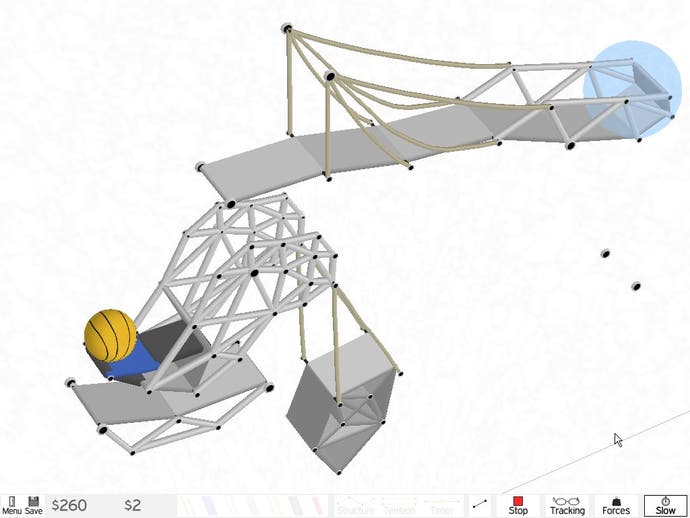Armadillo Run
Constructive criticism.
Britain is heading for a serious engineer shortage according to CBI Director-general Richard Lambert. He reckons the reason so few UK students take physics at A-Level then go on to do engineering degrees is the evil combined science GCSE and the lack of inspirational secondary school science teachers. Personally I put it down to the fact that Armadillo Run isn't part of the national curriculum.
This brilliant physics-based puzzle game has the power to turn even the most ardent science hater into a budding Brunel, Eiffel, or Dyson. However addicted you are to slaughter or strategising AR will seduce you, I guarantee it. The concept is really simple. Each level consists of an inanimate basketball-like armadillo, a blue destination portal and some anchor-points or pre-built structures. Using elements like rope, steel, elastic, and rockets you have to build a device that will get the armadillo to the portal.
Money for old rope
Naturally, there's a catch. Every level has its own budget and all the building materials have their own associated costs. The obvious way to solve Level 27 might be to build a gently sloping steel ramp from armadillo to portal, but you haven't been given nearly enough money for that so a more minimal, more imaginative solution must be sought. Level 40 would be a push-over if you had enough cash to construct a rocket-propelled elevator, but the funds provided aren't sufficient so you'll have to experiment with counterweights or an elastic-powered cannon.
The joy of the experimentation is that there are no time limits or penalties for failure, and (this factor is very important) you know you aren't rummaging around in a haystack hunting for just one pre-hidden needle. The realistic physics and wide range of building materials mean there are literally hundreds of unique ways of solving most of the scenarios. Sometimes you even achieve success accidentally when a part of your design breaks or behaves unexpectedly. In a level I've just completed, I was working on an elaborate system of interconnected seesaws. After one rather optimistic alteration, the first seesaw decided to self-destruct mid-test creating a sort of accidental trebuchet that lobbed the orange orb directly into the portal hammock. "Result!" as Alexander Fleming once famously uttered.
Time-bombs and tightropes

Destruction is actually pretty important in the game. Not only can you position and link lengths of metal, fabric, rope, rubber, and elastic anywhere on the screen, you can also adjust their tension, and prime them to snap with miniature explosives. Why on Earth would you want to do a mad thing like that? Well lets say you're planning to move the armadillo across the screen on a home-made swing; you might fix the raised swing onto the end of a platform with a primed steel strut. The charge on the strut would be set to blow once the armadillo had rolled into position. Maybe another charge-released device would snatch the swing with a jolt when it reached the other side, allowing the animal to tumble out and continue on its merry way.
If tensioning ropes and setting bomb timers sounds a bit involved then it's worth pointing-out that tricks like these are really only important later in the game. AR has a pretty straightforward interface and a very gentle learning curve. Ten engaging mini-challenges introduce the various gameplay elements and controls; 50 missions then gradually ramp-up the challenge and the complexity. Given the simple ingredients and the unchanging objective, it's remarkable just how diverse these missions are. Looking back through my library of auto-saved solutions, I can see huge rocket-driven Ferris wheels, elaborate rollercoaster-style rail systems, giant guillotines, massive golf clubs, colossal cobwebs of rope and elastic... With half-built mechanisms pre-positioned at the start of scenarios you are sometimes nudged in certain creative directions, but much of the variety is a natural by-product of a great design.
Floorless and flawless?

Picking holes in AR is pleasingly hard, but I guess some gamers might fall foul of the linear scenario structure. To progress you must solve each puzzle in turn, so there's potential for getting stuck. The experimentation-based gameplay makes this highly unlikely however (tweak a design for long enough and you are almost certain to come-up with something successful) and even if it does happen there are hints and downloadable solutions available at armadillorun.com. Very occasionally I find myself yearning for a toggleable grid underlay to help with symmetrical designs, but this is another very minor complaint.
Although the game has never had a retail release, it's already attracted an enthusiastic and industrious community. The download section of the official site is groaning with excellent user-made levels, built with the aid of the bundled editor. Most are designed as single puzzles or multi-puzzle sets. A few are 'spectator levels' - non-interactive contraptions designed to be watched rather than played. If you're ever short of mechanical inspiration be sure to download and devour kinetic masterpieces like 'And Back Again' and 'Crazy Armadillo'. You won't see many more pleasing spectacles on your PC screen this year.
Now I've passed on the good news about how utterly wonderful Armadillo Run is, I now get to pass on the even better news. This delightful distraction is a measly ten quid, and it can be in your grasping mitts in minutes (Assuming you've got a credit card or a PayPal account that is) How can the developers sell something so good so cheaply? Mainly by being a one-man-band (Peter Stock is the chap responsible) and cutting mercenary publishers out of the equation. The only place you can buy this gem is armadillorun.com. Go there now. Spherical South American Spaldings wait patiently for your rocket sledges and rope bridges.
